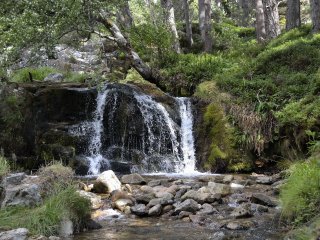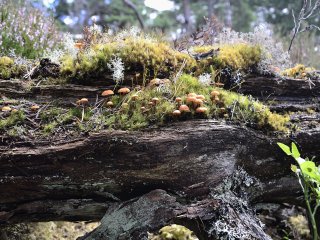Group leaders off duty
A lot of people ask me, what do Conservation Week leaders do when we’re not running weeks? Well the real answer is just as varied as the amazing people who lead these weeks, but for the purposes of this article I can reveal what some of us were up to in early August.
Once a year as many of us as possible meet up for a gathering which gives us a chance to share good practice, meet socially and get updates on what Trees for Life is planning for the future years. We were delayed this year due to the travelling conditions at the end of February, but we were met with much more amenable weather when we started to arrive at the Trees for Life Dundreggan Estate.
It’s pretty unusual for so many Group Leaders to meet at the same time, and in fact we’re still working on the correct collective noun (answers on a postcard, if you are old enough to know what a postcard is). So it’s always a special event and a great opportunity to meet old friends and make new ones. This year the sessions included updates from several staff members including Steve our CEO, Karen who looks after communications and fundraising, and Tomas our Finance Manager.

Usually group leaders organise and lead some sessions and this year this included a practical session on tree planting and site management, and important updates on issues such as safeguarding. Another highlight was a walk in the woodlands around the Dundreggan estate led by our Operations Manager, Doug Gilbert. The experience of being able to walk and talk whilst surrounded by the forest we are all involved in restoring is an essential reminder of what we’re working towards. Doug was able to point out the signs of ongoing regeneration at Dundreggan and took us to a spot where he’d recently seen a red squirrel, which are increasingly seen in the area.
This element of getting immersed in healthy regenerating woodland was on my mind before heading to Dundreggan and as I’m a bit of a wild camping fan myself and Neil, another Conservation Week leader, had discussed a trip to Glen Feshie on the journey home from Dundreggan.
Glen Feshie is a rewilding project on a similar scale to Dundreggan or Glen Affric (it’s listed on the same page as Trees for Life on the Rewilding Britain website if you want to look it up. I’d never visited before but Neil knew the area well and did a grand job introducing me to the place. We happily wandered along the glen from the car park for hours and were surrounded all the way by regenerating Scots pine, birch, juniper, willow and rowan on a scale I’ve rarely seen before. The tree line is extending naturally up the mountain and according to Neil had expanded noticeably since his previous visit just a few years previously.

After finding an idyllic camping site near the impressively braided River Feshie we settled in for the night knowing the next day might be a tough one. The next morning we followed a well-constructed trail up on to the Cairngorm plateau at about 1000m. On the way we kept ourselves busy identifying the various species of berry which were in fruit. Blaeberry, cowberry, crowberry, cloudberry and bunchberry were all in evidence. With patience, and if you weren’t overly fussy, a reasonable fruit salad was a possibility.
Once we’d made camp we had time to visit a couple of nearby munros (Scottish mountains above 3000 feet/914m) which weren’t in fact quite as near as they looked on the map, but we certainly slept well afterwards. We walked out along the floor of the glen the next morning, enjoying a final brew up in the shelter of some pine trees as some rain showers came through. All in all we’d had a great trip and I look forward to visiting again and seeing how the forest continues to develop.
There were many times throughout the few days I’d spent at Dundreggan and Glen Feshie that I felt very grateful I’ve been able to get involved with Trees for Life and forest restoration. It’s a tough job visiting some of the most beautiful parts of Scotland, but, as I’m trying to avoid clichés, you can finish that sentence yourselves.

